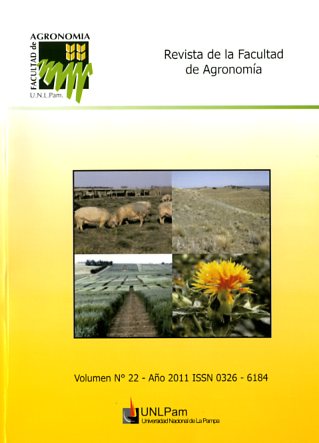Porcine meat quallty. Evaluation of technological carcass properties in pig feo thermo process sorghum in the Pampean Semiarid Region
Keywords:
pig carcass, meat quality, thermo process sorghumAbstract
Three factors are relevant to consumer's meat quality the tenderness, juiciness and flavor. Objective measurements are related to them as the pH1 and pH24 (1 and 24 hours post mortem), intramuscular lipid content and tenderness, latter as determined by the water asset capacity and cut force of Longissimus dorsi muscle. The pH is associated with tenderness and pH1 (5.5 - 6.3) is generally suitable for fresh meat supply. On the other hand the acidity is linked with quality pork sausage cooked and dry. The purpose of this investigation was to determine whether to process the grain sorghum pressure - high temperature prior to inclusion in the diets of growing and finíshing pigs. can improve carcass quality compared to raw corno The pH of the 1st hour and after 24 hours was significantly different in the control diet of corn relative to sorghum, aspect that determines a meat less water retention in fresh and best resistance to cutting to have less tenderness. Pigs fed sorghum treated exposed carcass best for fresh consumption, for its slow decrease of pH in the first 24 hours, by greater water retention in fresh meat, as measured at water loss by cooking and tenderness of the cut.Downloads
References
Barton Grade, P. 1997. En: Manipulating Pig Production VI. (Ed. P.D. Cranweli). Australasian Pig Sci. Assoc. pp. 100-123.
Benito, J. 1996. En: Zootecnia. Bases de Producción Animal VI. Cardó Buxadé Ediciones. Mundiprensa, Madrid.pp315-331.
Cobos, A., L. de la Hoz; M.1. Cambero & J.A. Ordóñez. 1993. Revisión: Influencia de la dieta animal en los ácidos grasos de los lípidos de la carne. Revista Española de Ciencia y Tecnología de Alimentos 34: 35 -51.
Eggert, J.M., C.A. Stahl, M.A. Latour, B.T. Richert & A.P. Schinckel. 1999. Factors of significance for pork quality. J. Anim. Sci. 77 (Suppl. 1): 169.
Gardner, G.A. & T.J.R. Coopero 1979. Growth and meat quality relations in pigs. En: Proc. of 25th European Meat Workers. Budapest, Hungria: 5- 8.
Honikel, K.O. 1997. Reference methods supported by OECD and their use in Mediterranean meat products. Food Chemistry. 9: 573 - 582.
Honikel, K.O. 1998. Reference Methods for the assessment of physical characteristics of meat. Meat Science 49: 447 - 457.
Lehninger, A.L. 1981. Bioquímica. 2 a Edición Omega. Barcelona. 806 p.
Milligan, S.D.; C.B. Ramsey, M.F. Miller, C.S. Kaster & L.D. Thompson. 1998. Resting pigs and hot fat trimming and accelerated chilling of carcasses to improve pork quality. J Anim Sci. 76: 74 - 86.
National Research Council (NRC). 2001. Nutrient Requirement of swine. (Ed. National Academy of Sciences). Washington, D.C., USA. 68 P
Nuernberg, K.. , K. Fischer; G. Nuernberg, U. Kuechenmeister, D. Klosowska, G. Eliminowska-Wenda, 1. Fiedler & K. Ender. 2005. Effects of dietary olive and linseed oil on lipid composition, meat quality, sensory characteristics and muscle structure in pigs. Meat Science, 70: 63 - 74.
Oliver, MA, U.weiler; K. Fischer, M. Font, M.Gispert, A. Diestre & R. Claus. 1998. Current trends in the quality of pork. Proc., 44th International Congress of Meat Science and Techno logy: 816.
Ordóñez, J. A.; M. 1. Camber; L. Fernández, M. L. García, G. Gracia de Fernando, L. De La Hoz & M.D. Selgaz. 1998. Cambios post mortem del músculo En: Tecnología de los alimentos. Vol. 11. Alimentos de origen animal. (Ed. Síntesis S.A), Madrid pp. 170-184.
Pearson, A.M. & F.w. Tauber. 1984. Processed meats. Second Edition. Avi Publishing Company. Westport, Connecticut. 203 p.
Pérez, M.P; J. Palacir, M.P. Santolaria, M.C Del Acena, G. Chacon, M.T. Verde, J.H. Calvo, M.P. Zaragoza, M. Gascon & S. Garcia-Belenguer. 2002. Influence of lairage time on some welfare and meat quality parameters in pigs. Veterinary Record. 33: 239-250.
Pethick, R.D., D.W. Warner; D.N. D'souza & d F.D. Dusnhea. 1997. Nutritional manipulation of meat quality. En: Manipulating Pig Production VI. (Ed. Cranwell, P.D.) Australasian Pig Sci. Assoc.: 91-99.
Terlouw, C. 2005. Stress reactions at slaughter and meat qua lity in pigs: genetic background and prior experience: A brief review of recent findings. Livest. Prod. Sci. 94: 125-135.
Downloads
Published
Issue
Section
License
La Editorial de la Universidad Nacional de La Pampa (EdUNLPam) exigirá a los/as autores/as la firma del siguiente documento:
La EdUNLPam lleva a cabo la publicación del artículo: (Título del Artículo) en SEMIÁRIDA Rev.Fac.Agron UNLPam ISSN 2362-4337 (impresa) ISSN 2408-4077 (en línea), del cual el/los abajo firmantes son autores de una o más partes. En el mismo acto, el/los autores entregan exclusivamente a la EdUNLPam todos sus derechos protegidos por las leyes de propiedad intelectual que rigen en la Argentina para reproducir, publicar, editar, fijar, comunicar y transmitir públicamente en cualquier formato o medio impreso o electrónico, inclusive internet, el artículo enviado a publicación e incluirlo en índices o bases de datos nacionales e internacionales. A cambio, la EdUNLPam entrega a los autores la autorización para la publicación o reimpresión con ines académicos y educativos en cualquier libro o medio de divulgación, con la sola obligación de citar el artículo original publicado en la EdUNLPam. Cada autor acuerda en que el material provisto a la EdUNLPam es un trabajo original, que no ha sido impreso o publicado en cualquier otro medio con anterioridad y que no vulnera derechos de terceros. El Primer autor tendrá la posibilidad de leer y corregir el artículo ya editado como “prueba de galera”, pero si el autor no devolviera esas correcciones de la prueba de galera dentro del tiempo especificado, el proceso de producción y publicación podrá proseguir sin la aprobación del autor. El/los autor/es no recibirán compensación monetaria de la EdUNLPam por el uso del material contenido en este artículo y asumen la responsabilidad de las opiniones vertidas en él.






.png)



22.png)



.jpg)




.jpg)
